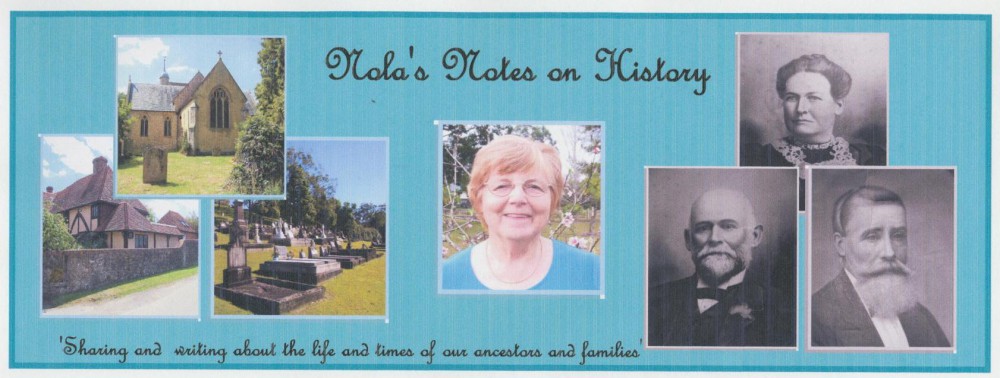When we are researching our family history, most of our energy goes into finding the documents that show the events of birth, marriage, and death of our ancestors. However, to build a picture of the lives of our ancestors we need to research the time, place, and the people involved in these events.
In a former blog, I wrote about the marriage of my ancestors, George Bell and Sarah Sargent at Sutton Forest in 1844. [See blog Our Bell Family in Australia-George Bell’s Marriage 1844‘ posted 9 August 2020].
Now I needed to research the place, Sutton Forest; the church, All Saints Church of England; the Minister, Rev William Stone and the witnesses, Robert Wallace and Mary Thomas as well as George and Sarah themselves.

The graveyard and All Saints Anglican Church (1861).
Sutton Forest
Sutton Forest was named by Commissioner Bigge when he traveled through the area in 1820 with Governor Macquarie. It was on the edge of ‘settlement’ on the Great South Road. It was named after the Speaker of the House of Commons in England. Political motives were always in mind when naming places in New South Wales in our early history.
A private village grew up here in the late 1820s when the land was made available for a church and cemetery in 1828. By the following year, a weatherboard chapel had been erected and was in use. This was where George Bell and Sarah Sargent’s wedding took place in 1844. [See blog Our Bell Family in Australia- George Bell’s Marriage 1844′ posted on 9 August 2020).
The neat stone building standing today was built in 1861 to the plans of the Colonial Architect, Edmund Becket.
More information can be found at https://www.aussietowns.com.au/town/sutton-forest-ns
Rev William Stone
The Rev William Stone was appointed to Sutton Forest in 1843 to replace, Rev George Vidal. He served there many years until he retired in 1858. He remained living at Sutton Forest and died there in 1870. He was buried in the churchyard and has a headstone.
The first school at Sutton Forest was opened in late 1830 with 18 pupils, under the instruction of John Eyre, a convict who had arrived that year. It had been built adjacent to the church. It was a church school and the local families continued to support it and it stayed in use until 1880 when the public school was opened.
A small cottage near the school was where the teacher and his family resided.
Robert Wallace
In the early 1840s, Robert Wallace was appointed as a teacher. He is believed to have been a friend of the Sargent family and that is how he became a witness at the wedding of George Bell and Sarah Sargent.
Mary Thomas
The other witness to the wedding was Mary Thomas the wife of James Thomas. They too were farming in the area and believed to be friends of the Sargent family. They later moved to The Oaks area near Picton, and in 1849 two of their sons were baptized at St Marks Church of England, Picton.
Sargents
The Sargent family, Thomas, his wife Alice (also spelled as Ellis in many records), and their four children emigrated on the Woodbridge in 1838. [See blog ‘Immigration -“Woodbridge” Voyage-1838 posted 28 July 2017.]
They settled in the area soon after arrival. Four more children were born there and were baptized in All Saints. Sarah was the second daughter and had been born in Beckley, Sussex in 1827.
Bells
James and George Bell emigrated as sailors on the convict ship Asia in 1837. [See blogs
See “A Window in Time-My Bell Family in East Farleigh, Kent, England“, posted 30 April 2014 and,” My Bell Family Ancestors-George Bell (1817-1894)-Sorting Red Herrings“, posted 3 July 2014.

A Jack and Jill Sussex Mill
Found at http://www.windmillworld.com/millid/2614.htm
After marriage George and Sarah Bell moved to Picton. In those days nearly fifty miles away over a rough and dangerous track. It is believed that Thomas Sargent was employed to help build a windmill on what was known for many years as Windmill Hill, which overlooked Picton. This was for the Larkin family, who were also of Sutton Forest. George and his brother James assisted him. It was built in wood and was in the ‘Sussex Style’. It was not successful as it was too far from the village and the wind was unreliable. George and James Bell made bricks and later assisted in building a steam-powered mill down on Stonequarry creek.
George and Sarah Bell’s children were all born at Picton. They were baptized there too. However, although George and Sarah were married in the Church of England at Sutton Forrest when it came to baptize their children, they took advantage of whichever minister was visiting the village at the time. Their children’s baptisms can be found in the Church of England, Presbyterian, and Wesleyan records.
More information on the Picton Windmills can be found at
https://www.environment.nsw.gov.au/heritageap/ViewHeritageItemDetails.aspx?ID=2690285
Information on the time period can be found at
https://myplace.edu.au/decades_timeline/1840/decade_landing_16_1.html
Most of all have fun with your research.
